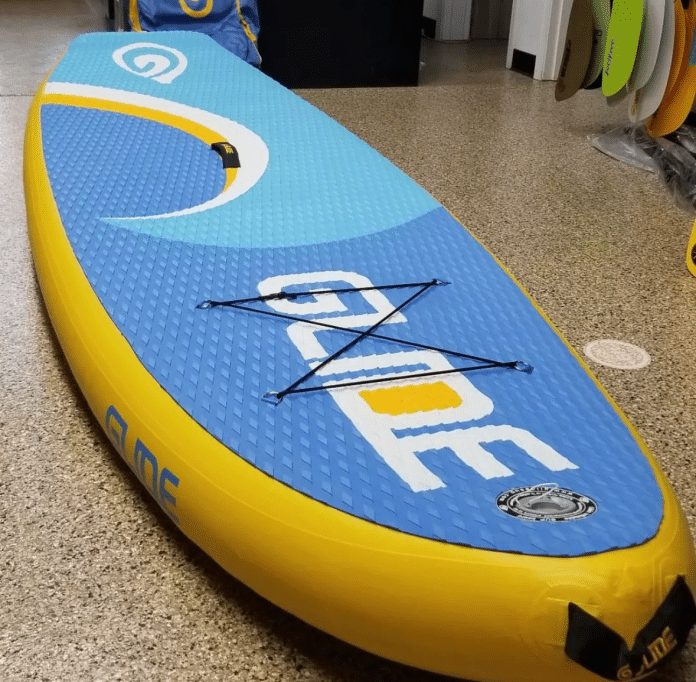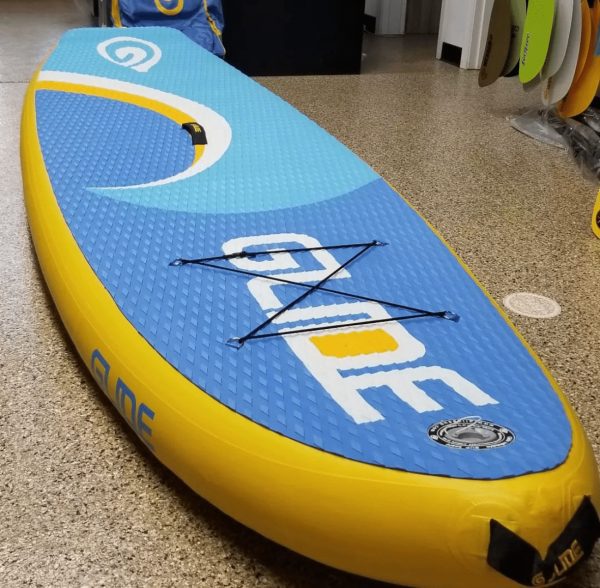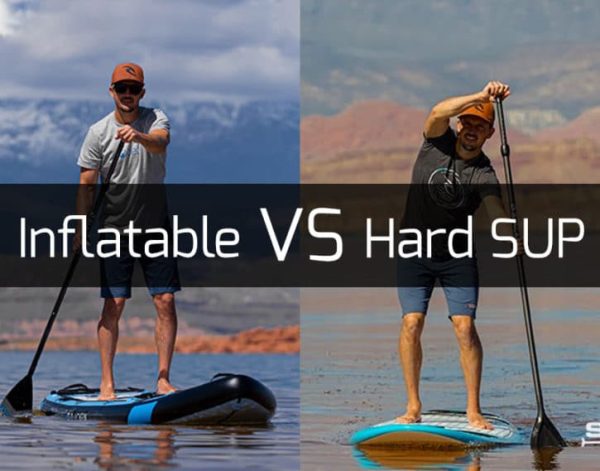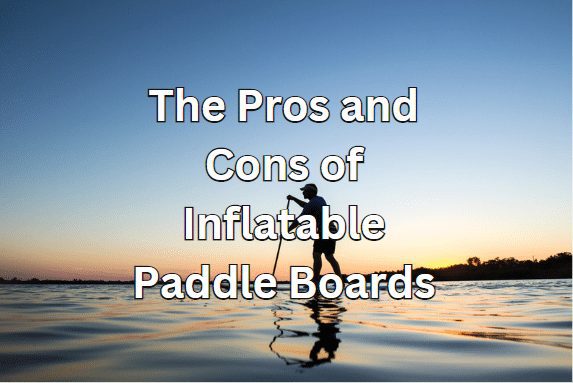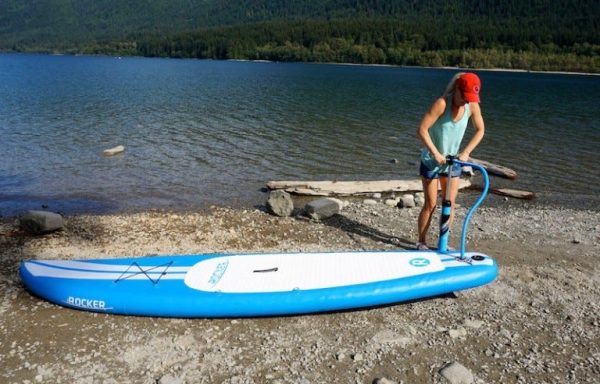Today, we’re exploring the downsides of inflatable paddle boards.
While these convenient and portable boards have gained popularity in recent years, there are a few drawbacks to consider.
From potential durability issues to limitations in performance, let’s dive into the disadvantages of the inflatable paddle board world.
This image is the property of isupworld.com.
1. Durability
Regarding durability, inflatable paddle boards have a few disadvantages compared to solid boards.
1.1. Vulnerability to Punctures
One of the main concerns with inflatable paddle boards is their vulnerability to punctures. Unlike solid boards, made from sturdy materials like fiberglass or carbon fiber, inflatable boards are made of PVC or similar materials more prone to punctures. This means that if you accidentally hit a sharp object like a rock or a piece of debris in the water, there is a higher risk of your paddle board getting punctured and deflating. While many inflatable boards come with repair kits, it can be a hassle to take the time to patch up a puncture, especially if you’re out on the water and far from shore.
1.2. Risk of Leaks
In addition to punctures, inflatable paddle boards also carry the risk of developing leaks. Over time, the air chambers of the board may start to develop tiny holes or weak spots, causing the air to leak out slowly. This could result in losing buoyancy and stability while on the water. While regular inspections and proper maintenance can help minimize the risk of leaks, it’s still something to be aware of and consider.
1.3. Susceptible to Wear and Tear
Due to their construction and materials, inflatable paddle boards are generally more susceptible to wear and tear than solid ones. The constant inflation and deflation, folding, and rolling of the board can cause the materials to weaken over time. This means you may need to replace your inflatable paddle board more frequently than a solid board. Additionally, exposure to elements like UV rays and extreme temperatures can accelerate the materials’ aging process, further reducing the board’s overall durability.
2. Performance
While inflatable paddle boards offer convenience and portability, they may compromise on specific aspects of performance when compared to solid boards.
2.1. Less Stability
One of the critical drawbacks of inflatable paddle boards is their reduced stability. Due to their inflatable nature, these boards tend to be less rigid and have more flex compared to solid boards. This can result in a less stable platform, especially in choppy or wavy conditions. While advancements in inflatable board technology have improved stability over the years, it’s important to note that they still may not match the stability of a solid board.
2.2. Reduced Maneuverability
Another aspect where inflatable paddle boards may lag behind their solid counterparts is maneuverability. The inherent flexibility of inflatable boards can make them slightly harder to control and maneuver, particularly in tighter turns or when navigating through obstacles. This can disadvantage those into SUP surfing or enjoy more aggressive paddle-boarding activities that require quick and precise movements.
2.3. Inferior Speed
Inflatable paddle boards generally have lower speed capabilities compared to solid boards. The flexible nature of the inflatable material creates more drag in the water, resulting in reduced glide efficiency. This means that you may have to put in more effort and paddling strokes to maintain a certain speed or match the performance of a solid board. If speed is a significant factor, it might be worth considering a solid board instead.
3. Portability
One of the significant advantages of inflatable paddle boards is their portability, but there are a few considerations to keep in mind.
3.1. Inflating and Deflating
While inflatable paddle boards can be easily inflated and deflated, this process requires time and effort. Depending on the size of the board and the type of pump you’re using, it can take 5 to 15 minutes to inflate the board entirely. Deflating the board and rolling it up neatly also takes time and can be a bit of a workout. A solid board may suit you if you’re always on the go and prefer a quick and hassle-free setup.
3.2. Transporting and Storage
Inflatable paddle boards have the upper hand in transport and storage. They can easily fit into a backpack or a compact carrying case when deflated and rolled up. This makes them convenient to transport in the trunk of a car or even as a carry-on item for air travel. Additionally, when space is limited at home, deflated boards can be stored in a closet or under a bed, saving you from needing dedicated storage space like a garage or shed.
4. Maintenance
Maintenance is essential when choosing any paddle board, and inflatable boards have their maintenance requirements.
4.1. Regular Cleaning
Like any water sports equipment, inflatable paddle boards require regular cleaning to prevent dirt, sand, or salt residue buildup. Cleaning an inflatable board is relatively simple and can be done using mild soap, water, and a soft brush. However, it’s essential to rinse the board thoroughly and allow it to dry completely before storing it to prevent mold or mildew growth.
4.2. Drying and Deflating
Proper drying and deflating of an inflatable paddle board is essential to prevent damage and prolong its lifespan. After each use, the board should be thoroughly dried to remove moisture.
This helps prevent the growth of mold, which can weaken the material and cause unpleasant odors. Additionally, deflating the board entirely before rolling it up for storage helps prevent unnecessary stress on the seams and chambers.
4.3. Repairs
Despite taking proper precautions, accidents can happen, and inflatable paddle boards are not exempt from the need for repairs. Fortunately, many inflatable boards come with repair kits, including adhesive patches and instructions for patching any punctures or leaks.
However, repairing a board can be time-consuming and may not always be a permanent solution. Depending on the extent of the damage, you may need to seek professional repair services or consider replacing the board altogether.
This image is the property of images. Surfers. Art.
5. Cost
The cost of an inflatable paddle board is another factor to consider, as it may differ from solid boards.
5.1. Higher Initial Investment
Inflatable paddle boards generally come at a higher initial investment than solid boards. The manufacturing process and materials used in inflatable boards contribute to their higher cost. While the upfront cost may be more significant, it’s important to weigh it against inflatable boards’ long-term value and convenience.
5.2. Additional Expenses
In addition to the initial investment, additional expenses may be associated with owning an inflatable paddle board. These include the cost of an air pump, if not included with the board, a repair kit for potential damages, and any accessories or attachments you may want to enhance your paddle board experience. Considering these potential expenses when budgeting for your paddle board purchase is essential.
6. Weight Restrictions
Another limitation of inflatable paddle boards is their weight capacity and impact on performance.
6.1. Limited Weight Capacity
Inflatable paddle boards typically have a lower weight capacity compared to solid boards. This means they may be unsuitable for heavier riders or those seeking extra gear or equipment for paddleboard adventures. It’s essential to check the weight capacity of each inflatable board and ensure that it can support your weight and any additional items you may want to bring along.
6.2. Impact on Performance
Exceeding the recommended weight capacity of an inflatable paddle board can significantly impact its performance. Overloading the board can cause it to sit lower in the water, reducing stability and maneuverability. It can also increase drag and make paddling more challenging. Choosing a board that matches your weight requirements is crucial to ensure optimal performance and safety on the water.
This image is the property of www.supboardguide.com.
7. Environmental Concerns
When considering any gear or equipment, it’s essential to evaluate the environmental impact, and inflatable paddle boards have a couple of considerations in this regard.
7.1. Use of Synthetic Materials
Most inflatable paddle boards are made from synthetic materials like PVC. While these materials contribute to the durability and flexibility of the boards, they are not biodegradable and can have negative environmental implications. The production and disposal of these materials can release harmful chemicals and contribute to pollution. However, some manufacturers now offer more eco-friendly and sustainable options, so it’s worth researching and choosing boards made from eco-conscious materials if environmental concerns are important to you.
7.2. Disposal
Disposing of an inflatable paddle board can also pose challenges. If the board reaches the end of its usable life or gets severely damaged beyond repair, it’s essential to handle its disposal responsibly. Many recycling centers may not accept inflatable boards due to the difficulty of recycling the materials. Check with local waste management facilities for proper disposal options, or consider repurposing the board for other creative uses.
8. Noise
Noise is another factor that could be considered a disadvantage of inflatable paddle boards.
8.1. Air Pump Noise
To inflate an inflatable paddle board, an air pump is required. While this may seem like a minor inconvenience, the noise generated by some air pumps can be pretty loud, significantly if you inflate the board early in the morning or in a quiet outdoor setting. This noise can disrupt the tranquility of the surroundings and may also disturb fellow paddle boarders or people nearby. Choosing a quieter air pump or being mindful of the timing and location of inflation can help mitigate this issue.
8.2. Squeaking
Inflatable paddle boards, especially older models or those not adequately maintained, may develop a squeaking noise. This can be caused by rubbing the inflatable material against itself or the deck pad. While not necessarily a critical issue, constant squeaking can be annoying and distract from the overall paddling experience. Proper maintenance, such as lubricating the valves or using anti-squeak sprays, can help alleviate this problem.
This image is the property of blog.lakefrontliving.com.
9. Surface Feel
The feel of the paddle board’s surface is another aspect that can differ between inflatable and solid boards.
9.1. Less Natural Texture
Inflatable paddle boards typically have a less natural texture on their surface compared to solid boards. The inflatable material tends to have a smoother feel, which can alter the overall paddling experience for some riders. Some paddlers prefer the textured feel of a solid board, which provides better grip and traction. However, this preference may vary from person to person, and some riders may not even notice a significant difference in surface feel.
9.2. Heat Retention
On a sunny day, the heat retention properties of inflatable paddle boards can be a disadvantage. The softer inflatable material tends to absorb and retain more heat than solid boards, which can make the surface uncomfortable to stand or kneel on. This can be especially noticeable in warmer climates or during the summer months. Using a deck pad or a towel to cover the board’s surface can help alleviate this issue and provide some insulation against the heat.
10. Design Limitations
Lastly, inflatable paddle boards’ design options and customization capabilities may be limited compared to solid boards.
10.1. Limited Shape Options
Inflatable paddle boards often come in a few standard shapes and sizes, limiting the variety of design options available.
This can be a drawback for those seeking specific board characteristics or specialized board shapes to excel in activities like racing or surfing. On the other hand, solid boards can be customized with various shapes and features to suit individual preferences and performance needs.
10.2. Lack of Customization
Besides the shape limitations, inflatable paddle boards offer limited customization options compared to solid boards. Solid boards allow you to choose different graphics, colors and finishes to match your style and preferences.
In contrast, inflatable boards usually come with a fixed design and branding, limiting your ability to personalize the look of your board. While this may not be a significant concern for everyone, it’s worth considering if aesthetics are important to you.
Overall, inflatable paddle boards provide a convenient and portable option for paddlers of all skill levels. However, they do come with their own set of disadvantages. From durability concerns to performance limitations, maintenance requirements, and environmental considerations, it’s essential to carefully evaluate these factors before deciding.
By understanding the potential drawbacks of inflatable paddle boards, you can make an informed choice and find the board that best suits your needs and preferences.
This image is the property of miro.medium.com.

